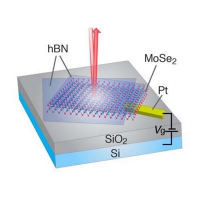News
Atomically Thin Mirrors Made from a Monolayer Semiconductor
Conventional mirrors have fundamental thickness limitations: the skin depth for metallic mirrors, and the wavelength of light for dielectric mirrors. Recently, the Park Group has demonstrated that these limitations can be overcome with the atomically thin semiconductor molybdenum diselenide [1].
To understand how this can be achieved, one has to consider how light is reflected from a material. An incident light wave causes oscillations of dipoles (separated positive and negative charges) within the material. These dipoles, which oscillate at the same frequency of the incoming light, re-radiate along the original light path or back towards the light source. The former radiation can destructively interfere with the incoming light, diminishing transmission, while the latter is exactly what we think of as reflection. This reflection is enhanced if there is a resonance, a frequency at which the dipoles oscillate more.
In realistic materials, dipoles lose energy not just by emitting light, but also by non-radiative loss channels, such as heating. In practice, the reflection depends on the ratio of how much of the dipole’s energy is converted into light, versus other decay channels.
Theoretical studies by the Yelin group have demonstrated that large resonant reflectivity can be realized in a two dimensional array of atoms [2], which are nearly perfect dipoles. The Park group has realized this effect with a solid state system: an atomically thin semiconductor. In these 2D materials, the reflective dipoles are excitons, bound pairs of electrons and holes. Excitons in molybdenum diselenide are particularly tightly bound compared to other semiconductors. For high quality devices, this translates into dipoles having a large rate of light emission, compared to non-radiative decay.
Moreover, these atomically thin mirrors can be switched on and off simply by applying a voltage to it. The electrical tunability has important technological implications, as it may allow these mirrors to be used as reconfigurable components in optoelectronic systems, such as active cavities, modulators, and metasurfaces.
[1] “Large excitonic reflectivity of monolayer MoSe2 encapsulated in hexagonal boron nitride,” Phys. Rev. Lett. 120, 037402 (2018).
[2] “Cooperative resonances in light scattering from two-dimensional atomic arrays,”
Phys. Rev. Lett. 118, 113601 (2017).
For more information about atomically thin mirrors, see:
Physical Review Letters Paper: “Large excitonic reflectivity of monolayer MoSe2 encapsulated in hexagonal boron nitride”
Nature News & Views: “Mirrors made of a single atomic layer”
APS Physics Feature: “Reflectivity of Ultrathin Mirror Switches with Voltage”
Chemistry World Article: “Atom thin mirrors’ reflectivity can be turned on and off”
